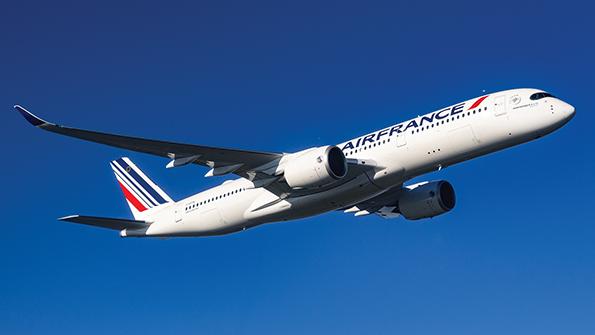
Almost a year after the European Commission set out a major legislative package aimed at helping meet long-term emission-reduction targets, airlines are mapping out how the new rules will shape their COVID-19 pandemic-related recovery and growth plans.
The European Union has set a binding target of achieving climate neutrality by 2050. Fit for 55, proposed last July, will work toward that goal through steps to reduce carbon dioxide emissions by 55% from 1990 levels by 2030.
- Next key vote on emissions trading scheme will be in early June
- Sustainable aviation fuel legislation to be discussed soon
- Aviation sector warns plans could affect connectivity
- Airlines also want action on airspace management reforms to boost efficiency
Cutting emissions from transport is a major part of the EU strategy. For aviation, a hard-to-decarbonize sector, the new legislation covers some policy areas that will have a major impact on operations: reforming emissions trading, fuel taxation and sustainable aviation fuels (SAF).
These measures are designed to make a more immediate impact on emissions while the industry works in parallel on the technologies, such as electric aircraft, that would dramatically cut aviation’s carbon dioxide (CO2) emissions—but are still far off from entering commercial operation.
For their part, European airlines want to make sure the Fit for 55 measures adopted do not harm their competitiveness against carriers based elsewhere that are subject to different sustainability policies, nor their capacity to invest in the new technologies.
Meanwhile, the legislation is progressing. On May 17, the European Parliament’s Committee on Environment, Public Health and Food Safety adopted draft laws. Among them are reforms that will allow long-haul flights departing the European Economic Area (EEA), as well as flights within it, to be included in the EU Emissions Trading System (ETS); the phasing out of free emissions allowances for airlines two years earlier than planned; and moves to step up monitoring, including of airlines’ non-CO2 emissions.
That last proposal could be a step on the way to extending the scope of the EU ETS to cover non-CO2 aviation emissions, if deemed appropriate, the committee said.
The committee voted to end free emissions trading allocations to the aviation sector by 2025, two years ahead of the timetable set out by the European Commission.
Environmental campaigners praised the tougher approach, in particular the scope for including long-haul flights, but an airline industry group warned the new rules could harm a sector just getting back on its feet after two tough years.
Airlines for Europe (A4E) said: “Phasing out free allowances by 2025—even before decarbonization technologies such as sustainable aviation fuels are widely available, will only make traveling in Europe more expensive.”
The group warned that higher prices for intra-EEA travel would negatively affect connectivity and tourism. “It will also distort competition and lead to carbon leakage. In the absence of a global carbon price for air transport, consumers may opt to travel to non-EU destinations or transit outside of the EEA to avoid these new costs, for example for travel to holiday destinations outside of Europe,” A4E added.
The International Air Transport Association’s (IATA) regional vice president for Europe, Rafael Schvartzman, warned that Fit for 55, in its current form, could damage European airlines’ competitiveness for only a marginal CO2 reduction.
“We will encourage the EU to apply the Corsia international carbon offsetting scheme to intra-European aviation, and the idea of a jet fuel tax must be dropped,” he said at Routes Europe 2022 in Bergen, Norway, on May 19.
Schvartzman said there was still time to amend Fit for 55, but that as it stands, the package “could mean the end of affordable European air travel and throw into reverse a process [that] has democratized travel for millions of European citizens.”
The next step for the legislation is a vote during the European Parliament’s June 6-9 plenary session, after which negotiations with EU governments will begin.
Although increased clarity on where the reforms are headed is one piece of good news for airlines, they still have many concerns about how that legislation and other elements of Fit for 55 will apply to the sector.
Understandably, after two years of deep crisis, one of their biggest concerns is how much implementing all the new emissions-cutting measures will cost.
Compliance with ETS, in parallel with the International Civil Aviation Organization’s Corsia scheme, will represent the biggest short-term cost for European airlines, says Managing Director A4E Thomas Reynaert.
A4E, whose members include major airlines such as Air France-KLM, Lufthansa, Ryanair, Finnair and EasyJet, notes that aviation decarbonization efforts may be counterproductive if they increase airlines’ costs too much, slowing investment in technologies that will make a huge difference in the sector’s carbon footprint when they become available.
The airline group also wants European authorities to focus on reforms of the region’s airspace management, an area not addressed under Fit for 55, but which the industry says could lead to 10% fuel savings.
ReFuelEU, the part of the Fit for 55 legislation that aims to encourage—require in fact—more use of SAFs, will also come under close scrutiny from the aviation industry when it is discussed in the coming weeks.
As the proposal stands, it requires airlines to blend a growing proportion of SAF—2% in 2025, rising to 63% in 2050. It also sets out a required proportion of synthetic fuel: 0.7% in 2030, rising to 28% in 2050.
SAF, including biofuels and synthetic fuels, currently accounts for only 0.05% of all aviation fuel consumption, according to pre-pandemic European Commission statistics. Their increased use will be an important part of the aviation sector’s efforts to cut emissions.
There are also operational concerns, Schvartzman said. “The recognition of the importance of SAF in the Fit for 55 initiative is welcome. But it doesn’t make sense to propose that SAF must be delivered at almost every airport in Europe. A more flexible booking-claim system would enable airlines to purchase SAF where it is most economically efficient,” he noted.
Increased SAF use will also come at a price. SAF is typically two to six times more expensive than kerosene, according to network manager Eurocontrol, which published a think paper on the sector’s decarbonization efforts May 12. The report concluded that under high, low and baseline traffic scenarios it has set out through 2050, the 55% reduction in emissions is possible but relies heavily on market-based measures, most notably the ETS.
“There is a pressing need to ramp up swiftly SAF production and usage, enabling SAFs to compete with conventional kerosene,” said Eurocontrol Director General Eamonn Brennan.
The main issue holding back SAF is its lack of availability, European airlines say. “We all know that it is very expensive and availability is poor,” says Air France CEO Anne Rigail. To meet its own emission-reduction targets, the airline will need to use more than 10% SAF by 2030. “The question is will the energy providers invest sufficiently [so] that we can find easily, in Europe, and not only in LA or San Francisco, some sustainable fuel,” she says.
While national SAF subsidies could help stimulate the sector, a lack of coordination would make them less effective, as member states opt to prioritize different areas of clean aviation technology research.
“In Europe, they’re very good at showing the stick to regulate, but they hardly give you the carrot to actually make it work,” Reynaert says. National subsidies would be “better than nothing, but I don’t think it will give you a harmonized European solution,” he says.
A4E is in favor of SAF allowances, included in the latest package approved on May 17, which allow airlines to obtain a credit against an ETS allowance every time they use SAF in the EU, an incentive to go beyond the minimum targets. “It’s a practical way to alleviate at least part of the burden. Because the cost burden of course will be huge,” Reynaert says, noting that the concept should fit in easily with the existing ETS scheme.
Sourcing enough, and affordable, SAF is expected to be a challenge for airlines well into the 2030s. “Both ETS and SAF will be major cost burdens for airlines, but it depends on market developments. As we get more scale of SAF, SAF should be getting cheaper,” Reynaert says.
The hydrogen industry welcomed the European Commission’s May 18 release of REPowerEU—its plans to end the bloc’s dependence on Russian oil and gas—which includes hydrogen targets.
Industry group Hydrogen Europe called for more ambitious synthetic fuel targets for aviation within ReFuelEU, saying legislation should target an increase in the 2030 subtarget for synthetic aviation fuel (e.g., e-kerosene) from the currently proposed 0.7% in line with a 5% target before 2035.
Elsewhere within the Fit for 55 plans, airlines contend that a Europe-wide fuel tax would harm connectivity, and without a clear plan for reinvesting revenues in green technologies, would not advance the drive to cut the sector’s emissions.
With more clarity on the ETS and its implementation alongside Corsia, as well as on fuel, expected by year-end, the industry will be gearing up to continue difficult discussions on the topic.
—With David Casey in Bergen, Norway

